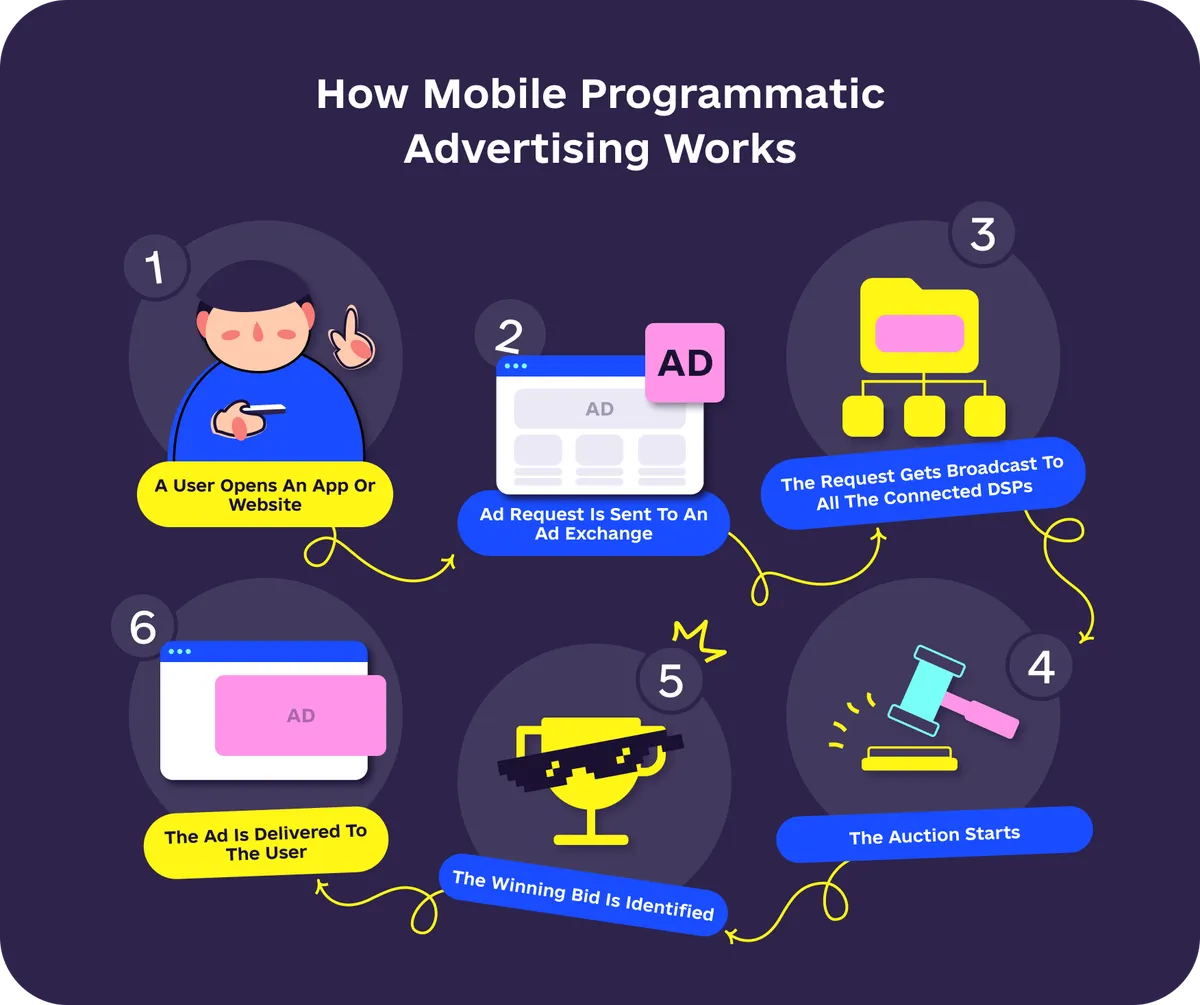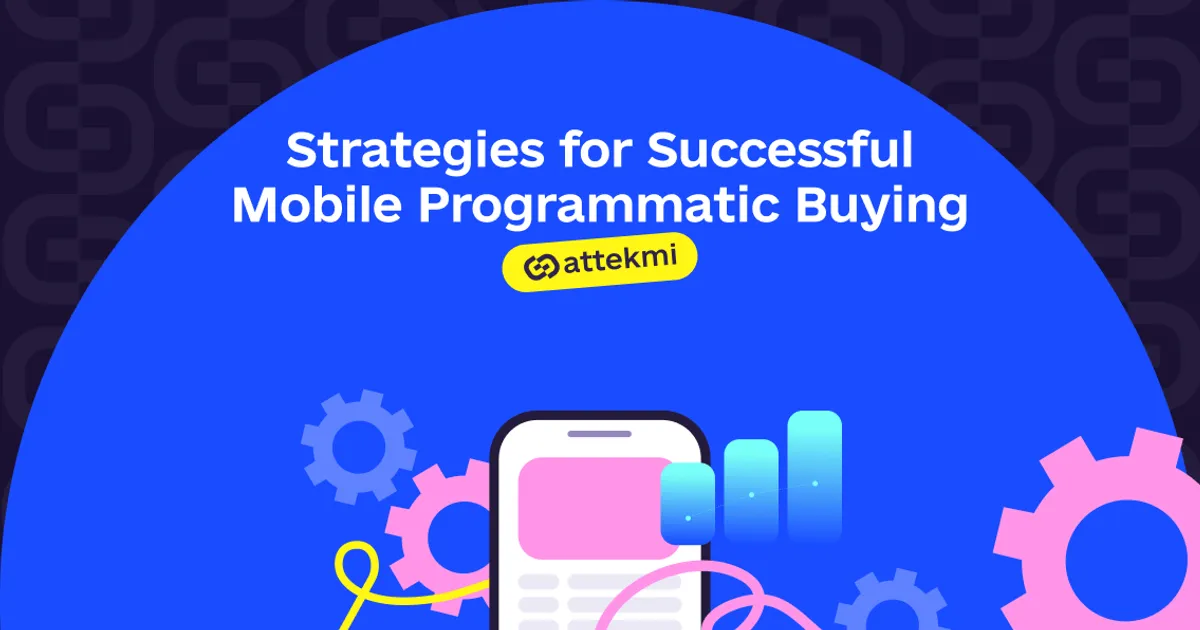An average user spends 3 hours and 15 minutes on their phone per day, making mobile media buying an effective method to reach customers wherever they are. However, marketing on social networks is not the only way for advertisers to drive engagement. Programmatic mobile advertising allows for achieving better results while significantly reducing human intervention. Let’s figure out what exactly this model implies and how you can benefit from it.
What is mobile programmatic advertising?
Powered by machine learning algorithms, programmatic mobile ad buying enables advertisers to purchase mobile ad inventory automatically via a demand-side platform (DSP). Marketers only need to set up the campaign; the platform does the rest. For instance, in real-time bidding, the auction takes place at an ad exchange, and the whole process is completed within a couple of seconds.

5 strategies for successful mobile programmatic buying
Programmatic is more than buying ad slots — it implies “purchasing” specific audiences. Thus, instead of being shown on particular websites that can be visited by anyone, ads can be displayed on any website connected to the programmatic ecosystem and shown to users who are potentially interested in the promoted product or service. The model allows marketers to drive conversions more effectively, and taking the following steps is a way to reach this goal.
Select the right DSP
For advertisers, going programmatic means using a demand-side platform, so the first step is selecting a proper mobile DSP that would help achieve the desired results. Apart from checking if the platform supports mobile advertising, it would be useful to pay attention to the following:
A variety of targeting settings (the more options are available, the better)
Availability of features and filters for campaign optimization
A selection of programmatic models (for instance, a platform supporting both real-time bidding and direct deals ensures better flexibility)
Availability of A/B testing functionality
The presence of monitoring and analytical tools
Additionally, we recommend checking if the solution offers rewards and cooperates with trusted supply partners. If possible, request a demo, which will help you make a final decision.
Leverage the data
The success of any advertising campaign heavily relies on data, so first, it is essential to make a data-driven decision regarding the objectives of a specific campaign. For instance, this can be driving traffic or increasing brand awareness. Then, by analyzing the data, advertisers need to outline the audience’s demographics, preferences, online behavior, and other characteristics.
Continuous data collection is required to enhance targeting, although since the cookieless future is coming soon, marketers should prioritize first-party data and start adapting right now.
Optimize the creatives
The next step is to select the ad format — this should be done with the identified campaign objectives in mind. For example, a video ad can work great in case the goal is to drive traffic while informing the audience about a discount can be done with the help of banners.
Additionally, it is essential to optimize the creative as smartphone screens have rather limited space. Marketers need to make sure that the ad looks appealing and clear at the same time.
If the selected mobile DSP supports A/B testing, it would be helpful to test different messages and formats to identify the most effective approach.
Set up targeting
The final step before launching the campaign is to apply targeting settings: demographics, mobile geo-targeting, IAB categories, and others (the selection depends on the chosen DSP). In any case, the more settings are applied, the more targeted the campaign gets. Using available filters can also be helpful.
Monitor and optimize the campaigns
While focusing on key metrics relevant to the objectives, advertisers should continuously monitor the performance of any programmatic campaign. Doing so enables data-driven optimization of the analyzed campaign, as well as collecting insights for improving future campaigns. For example, the results delivered by a specific campaign can help get a better understanding of the audience, so the next ads will be more targeted.
Cost of mobile programmatic buying
In general, cost-effectiveness is on the list of benefits of programmatic advertising. While a lot of tasks are automated, the technology allows marketers to find the most attractive price across a large pool of publishers. Many DSPs also offer budget optimization features to prevent overspending.
Most platforms perform on the CPM (cost per mille) basis, meaning that advertisers pay per thousand impressions, although other pricing models like CPC (cost per click) are often available as well. The price depends on multiple factors, including but not limited to the format of the ad, its location on the page, the specificity of the audience, the level of competition, and the quality of the inventory.
The industry may also affect the cost of programmatic advertising. For instance, the bid floor rates for banner and native ads may be around $0.5 and $0.7, respectively. That’s not a lot, but advertisers may need to adjust their bids to get access to the top inventory. However, ad impressions are not the only item of expenditure, so let’s summarize programmatic expenses:
Expenses on ad delivery. As you already know, the price depends on various factors, so it is important to keep the budget flexible.
The DSP fee. This can be a flat rate, and on some platforms, the first payment is higher than the subsequent ones. Alternatively, the fee can be based on the spend percentage.
Data-related costs. In case advertisers lack data for targeting, they may need to purchase it from a third-party provider.
Technology-related costs. Marketers may need to invest in creative development software, ad verification services, ad fraud detection and analytics tools, etc. However, most DSPs are equipped with traffic verification and other features.
To come up with the mobile programmatic budget, advertisers should consider the fees of the selected DSP and its bid floor rates. It is crucial to remember that these rates are the minimum investments in ad impressions; most likely, the successful performance of the campaign will require more. That is why it is important to allocate more to ensure flexibility. Besides, marketers have to analyze the required technology and data, if necessary, and decide on the amount required for their acquisition.
Here are several recommendations on how programmatic expenses can be managed and optimized.
Review the tools that are already in use. Instead of investing in new software straight away, advertisers should go through the list of tools the company uses at the moment. For instance, there may be no need to subscribe to a new creative development service if the business already leverages one.
Look for free tools. Some essential tools may be available for free, which can help reduce costs.
Choose a DSP carefully. Look for a platform that is equipped with traffic and inventory scanners, analytics features, etc. This way, there will be no need to invest in additional tools. Besides, pay attention to the DSP fee and its type.
Keep the spending under control. Many DSPs allow marketers to limit the daily spend or the number of daily impressions per visitor or IP.
Benefit from optimization features. A lot of demand-side platforms offer functionalities for keeping the bids optimal but competitive enough. Using them helps prevent unnecessary expenses.
Consider Attekmi your trusted partner
Mobile advertising spending has been continuously growing, and this trend is not likely to fade away. Therefore, owners of ad exchanges should meet the needs of their supply and demand partners by offering them mobile programmatic advertising opportunities.
With Attekmi solutions, this task is simple. Our platforms support mobile web and in-app environments, along with desktop and CTV, and the range of mobile ad formats includes banner, video, audio, native, and pop ads. By applying multiple targeting and filtering features, you will be able to match mobile advertisers and publishers effectively and, as a result, drive income.
Instead of investing time and money in building a mobile ad exchange from scratch, you can get your solution much faster and start earning on media trading straight away.
Conclusions
Nowadays, programmatic is among the most effective models in the mobile advertising industry. Automation and accurate targeting allow marketers to reach their audiences effectively while optimizing expenses. In turn, for publishers, this is an opportunity to monetize their inventory with ease.
To meet their needs, programmatic platforms need to support mobile advertising, and ad exchanges are not an exception. Choosing solutions like those offered by Attekmi allows for entering the mobile programmatic market quickly and cost-effectively, which is the best option for those planning to earn on media trading.
Does Attekmi seem like the right choice? Contact us!
FAQ
How does mobile programmatic work?
This type of advertising is powered by machine learning algorithms, which allow for automating multiple processes. Advertisers leverage demand-side platforms, while publishers use supply-side ones. The real-time bidding auction takes place at an ad exchange, and the winning ad is delivered to the publisher and displayed to a user within a few seconds.
What are the key benefits of mobile programmatic buying?
The main benefits are automation and precise targeting. Automation significantly accelerates the media buying process while targeting capabilities of demand-side platforms allow advertisers to reach exactly those users who are most likely to take the desired action. This has a positive impact on the overall performance of the campaign. Additionally, programmatic buying is a cost-effective approach.
How to measure the success of programmatic mobile ads?
Most demand-side platforms are equipped with analytics features, so there is usually no need for advertisers to invest in additional software for measuring the performance of their programmatic mobile ads. The metrics should be prioritized according to the campaign’s goals.
 By Iryna Kozirevych
By Iryna Kozirevych